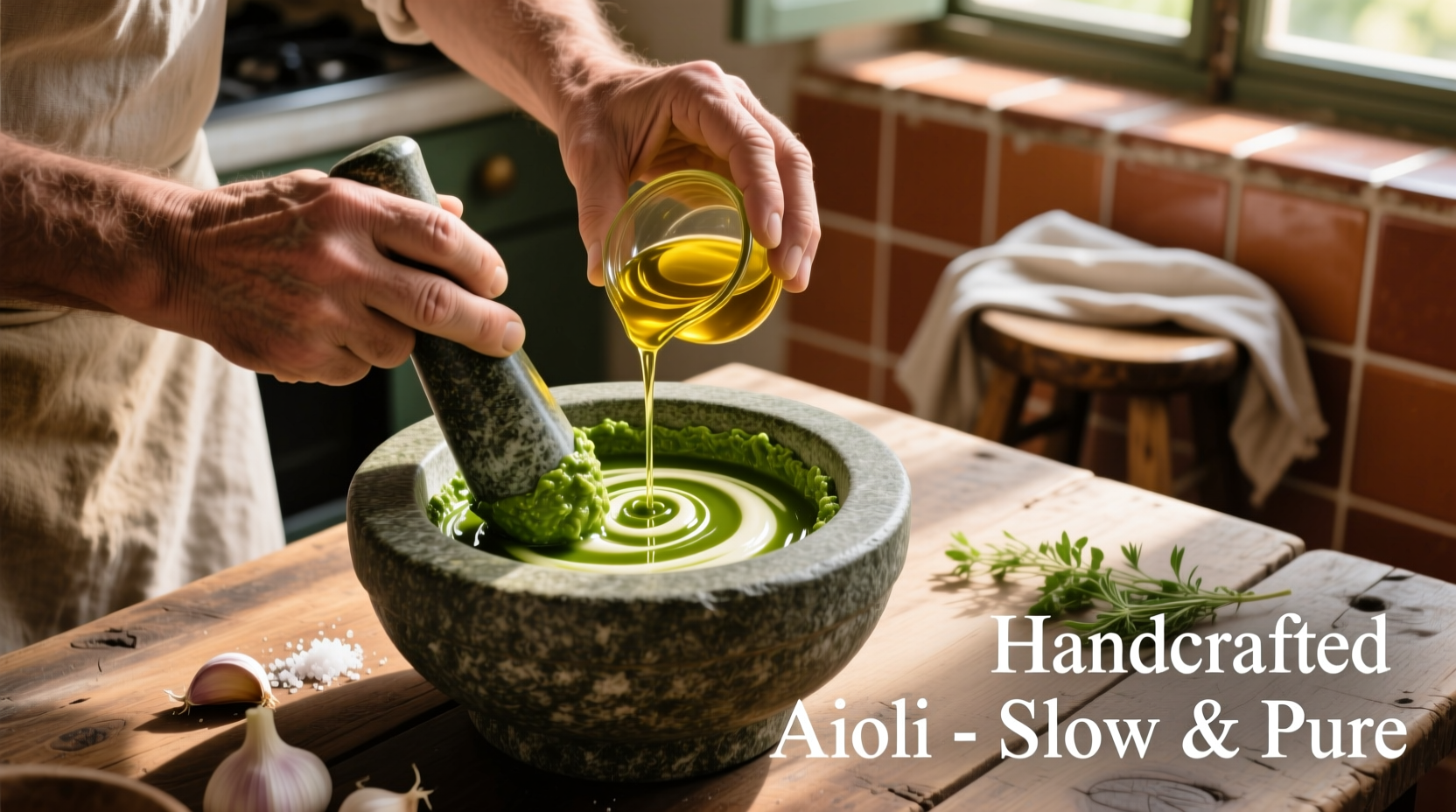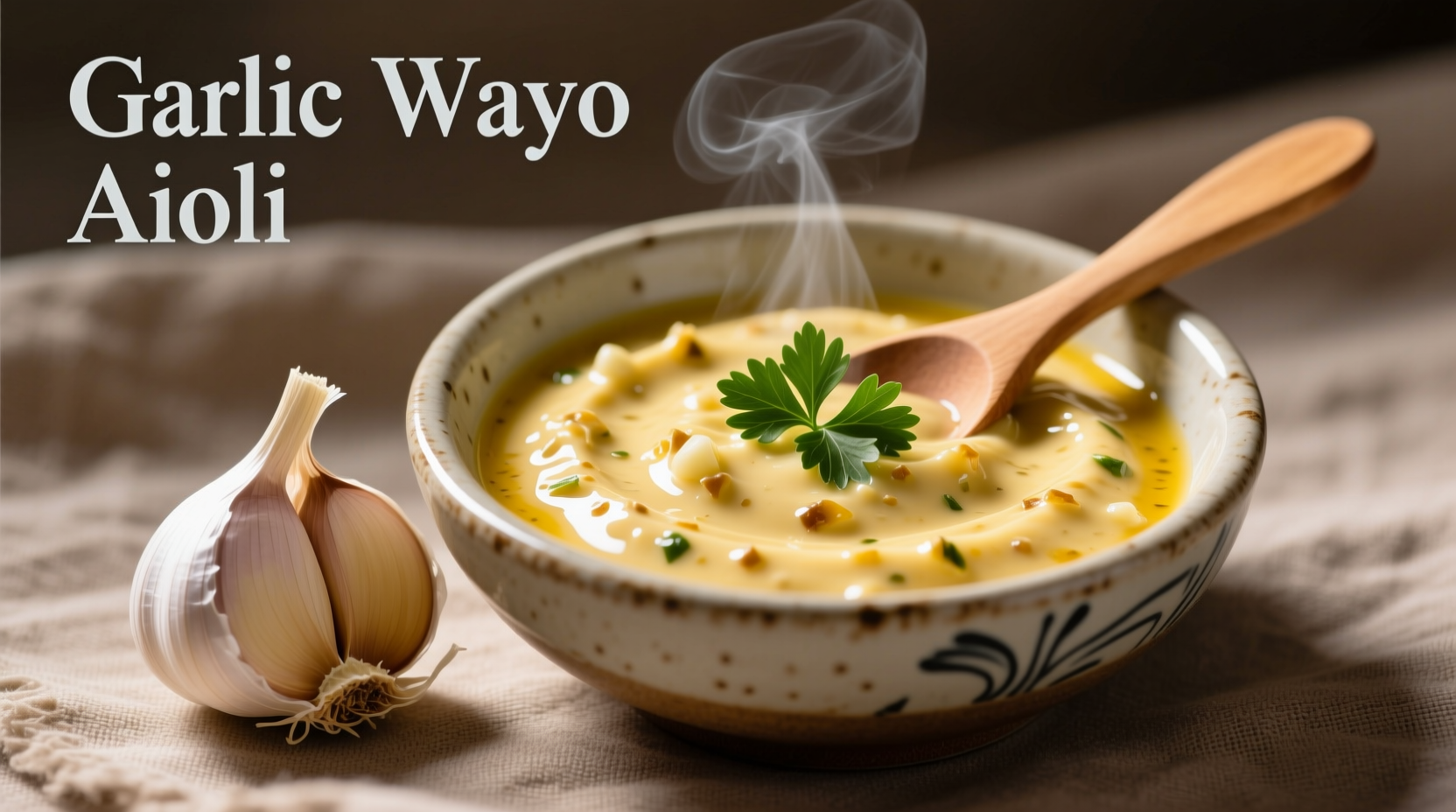Confused about whether you're making garlic mayo or authentic aioli? You're not alone. This culinary confusion affects home cooks and even some restaurants. Understanding the distinction isn't just food snobbery—it directly impacts flavor, texture, and how your sauces perform in different dishes. Let's clear up the confusion once and for all.
What Sets Them Apart: Ingredients and Technique
The most critical difference lies in their foundational ingredients and preparation methods. Authentic aioli has ancient Mediterranean roots as a simple emulsion of garlic and olive oil, traditionally pounded in a mortar. Modern garlic mayo starts with egg-based mayonnaise to which garlic is added.
| Characteristic | Traditional Aioli | Garlic Mayo |
|---|---|---|
| Base Ingredients | Garlic, extra virgin olive oil, salt | Egg yolks, oil, vinegar/lemon, garlic |
| Egg Content | No egg | Contains egg yolks |
| Traditional Preparation | Mortar and pestle | Whisk or blender |
| Flavor Profile | Sharp garlic, grassy olive oil notes | Milder garlic, creamy, tangy |
| Texture | Thicker, more rustic | Smoother, more uniform |
Historical Evolution: How the Confusion Began
Aioli's origins trace back centuries in Mediterranean coastal regions, particularly in Provence (France) and Catalonia (Spain). The name literally means "garlic and oil" in Provençal (ai = garlic, oli = oil). Traditional preparation required significant effort—garlic cloves were pounded in a mortar while slowly drizzling in olive oil until emulsified.
As commercial mayonnaise became widely available in the 20th century, cooks began adding garlic to this convenient base, creating what we now call garlic mayo. This adaptation spread rapidly through restaurants seeking efficiency, eventually leading to the common mislabeling of garlic-flavored mayo as "aioli"—a practice that continues today despite the technical inaccuracy.
When Substitution Works (and When It Doesn't)
Understanding the context boundaries for each sauce prevents culinary disappointment. While garlic mayo serves well as a sandwich spread or dip for casual occasions, authentic aioli shines in traditional Mediterranean preparations where its distinctive garlic-forward flavor and olive oil character are essential.
Consider these practical guidelines:
- Use authentic aioli with grilled fish, roasted vegetables, or in traditional dishes like salade niçoise where olive oil flavor complements other ingredients
- Garlic mayo works better for American-style burgers, sandwiches, or as a dipping sauce where a milder garlic flavor and creamier texture are preferred
- Avoid substituting when preparing traditional Provençal or Catalan dishes that specifically call for aioli
- Never heat authentic aioli as it will break—garlic mayo handles gentle warming better due to the egg stabilizers
Crafting Authentic Aioli: A Practical Guide
Creating true aioli requires patience but yields superior flavor. Start with these professional tips:
Traditional method: Crush 2-3 garlic cloves with a pinch of salt in a mortar until paste-like. Gradually drizzle in 1 cup of high-quality extra virgin olive oil while continuously pounding, creating a stable emulsion. This takes 10-15 minutes of patient work but produces unparalleled flavor.
Modern adaptation: For more consistent results, use a food processor. Combine 2 garlic cloves and pinch of salt, process until minced. With motor running, slowly drizzle 1 cup olive oil through feed tube until emulsified. This takes about 5 minutes but maintains authenticity without egg.
Troubleshooting tip: If your aioli breaks, stop adding oil. Whisk one teaspoon of warm water into the broken mixture, then slowly resume adding oil. The water helps re-establish the emulsion.

Practical Applications for Home Cooks
For everyday cooking, understanding these distinctions helps you make informed choices without unnecessary complexity:
When time is limited, enhance store-bought mayonnaise by adding freshly minced garlic, a squeeze of lemon juice, and a tablespoon of good olive oil. Let it rest for 30 minutes to develop flavors. While not authentic aioli, this "elevated garlic mayo" bridges the gap for most casual applications.
For special occasions or when preparing Mediterranean dishes, invest the time in making true aioli. The vibrant garlic flavor and grassy olive oil notes transform simple dishes like grilled asparagus, roasted potatoes, or fish tacos.
Remember that authentic aioli's flavor intensifies as it sits. Prepare it 1-2 hours before serving for optimal taste development, but don't make it more than 24 hours ahead as the garlic flavor becomes overpowering.
Preserving Culinary Authenticity
The distinction between garlic mayo and aioli represents more than technical accuracy—it preserves cultural culinary heritage. As noted by the Culinary Institute of America's research on Mediterranean cuisine, maintaining traditional preparation methods ensures we don't lose the nuanced flavors that define regional cuisines.
When dining out, don't hesitate to ask how a restaurant prepares their "aioli." Many establishments now specify whether they serve traditional garlic-oil emulsion or garlic-flavored mayonnaise, reflecting growing consumer awareness about authentic preparations.











 浙公网安备
33010002000092号
浙公网安备
33010002000092号 浙B2-20120091-4
浙B2-20120091-4